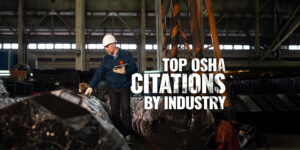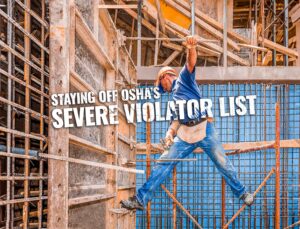Top 10 Safety Violations in Manufacturing
Manufacturing is an industry that requires strict adherence to safety regulations to ensure the health and well-being of employees, as well as the quality of the products produced. Unfortunately, there are still too many safety violations that occur in the manufacturing industry – causing billions of dollars in irreparable and tragic incidents. Here are the top 10 safety violations in manufacturing:
1. Lack of Personal Protective Equipment (PPE)
- Use of Personal Protective Equipment is crucial in a manufacturing setting, where workers are often exposed to hazardous chemicals, heavy machinery, and sharp objects. Failure to use PPE or using it improperly can result in serious injuries or fatalities.
2. Failure to Follow Lockout/Tagout Procedures
- Lockout/tagout procedures are used to ensure that equipment is safely shut off and unable to be turned on during maintenance or repair. Failure to follow these procedures can result in serious injuries or fatalities from accidental startup of equipment.
3. Inadequate Machine Guarding
- Machine guarding is designed to protect workers from the hazardous moving parts of machinery. Inadequate or improper machine guarding can result in serious injuries, including amputations and fatalities.
4. Lack of Hazard Communication
- Hazard communication is a regulatory requirement to inform workers about the potential dangers of the chemicals and substances they are working with. Failure to communicate these hazards can result in exposure to toxic substances or other hazardous conditions.
5. Electrical Safety Violations
- Electrical safety violations can include working on live electrical systems, failing to properly ground electrical equipment, or using damaged electrical equipment. These violations can result in serious electrical shock or electrocution.
6. Unsafe Forklift Operations
- Forklifts are commonly used in manufacturing settings to move heavy materials, but improper use or maintenance of forklifts can result in serious injuries or fatalities. Examples of unsafe forklift operations include speeding, overloading, and failure to maintain the forklift.
7. Lack of Fall Protection
- In manufacturing settings where workers are working at height, such as on mezzanines or catwalks, fall protection is necessary to prevent serious injuries or fatalities. Failure to provide or use fall protection can lead to falls from heights.
8. Improper Use of Chemicals
- Chemicals are commonly used in manufacturing settings, but improper use or handling of chemicals can result in serious injuries or illnesses, including chemical burns, respiratory problems, and even cancer.
9. Improper Lifting Techniques
- Improper lifting techniques can result in back injuries, strains, and sprains. In manufacturing settings where heavy lifting is required, it is important to provide training on proper lifting techniques to prevent these types of injuries.
10. Inadequate Fire Safety Precautions
- Manufacturing facilities can be at risk for fires due to the presence of flammable materials, chemicals, and equipment. Failure to have adequate fire safety precautions, such as fire alarms, sprinkler systems, and fire extinguishers, can result in serious injuries or fatalities in the event of a fire.
Safety violations in manufacturing are a serious concern and regularly cause injuries or fatalities. Employers should prioritize the safety of their workers by ensuring that all safety regulations are followed and that employees are properly trained on safe work practices. By doing so, employers can significantly reduce the number of accidents and injuries that occur in the manufacturing industry and create a safer work environment for everyone involved. Contact us today and learn more about our safety management software solutions.
Recommended Reading
TOP OSHA Citations by Industry
OSHA, or the Occupational Safety and Health Administration, is a government agency that enforces workplace safety regulations in the United States. One of their primary functions is to conduct inspections of workplaces to ensure compliance with these regulations. When violations are found, OSHA can issue citations and penalties. In this blog post, we will explore…
Staying off OSHA’s SVL (Severe Violator List)
Staying off of OSHA’s Severe Violator List is important for any business to maintain a safe work environment and avoid costly penalties. The Severe Violator List (SVL) is a program launched by the Occupational Safety and Health Administration (OSHA) to focus on employers who have committed severe or repeated violations of workplace safety regulations. Being…
Beating the Heat: Safeguarding Workers’ Health and Safety in Rising Temperatures
As temperatures continue to rise, heat-related illnesses have become a growing concern for both workers and employers. Working in extreme heat conditions poses significant risks to the health and safety of employees, making it essential for employers to take proactive measures to prevent heat-related illnesses. In this blog post, we will discuss the importance of…
SAFETY MANAGEMENT SIMPLIFIED
Prevent Tragedy and Scale Effectively by Making Safe Work Efficient




